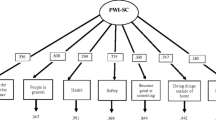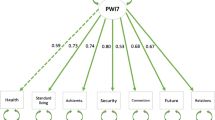Abstract
The Personal Well-being Index-school children (PWI-SC; Cummins and Lau 2005) measures well-being of adolescents. The study aimed at validating psychometric properties for the English and the Hindi translated version of PWI-SC in Indian context. Data from 1,301 students, aged 13–18 years (mean age = 15.40 years, SD = 1.33) was collected. The English and Hindi version confirmed one-factor solution of the PWI-SC. The convergent validity was supported through positive correlations with Flourishing Scale (FS; Diener et al. 2010) and Brief Multidimensional Students Life Satisfaction Scale (BMSLSS; Huebner et al. 2004). The effect of demographic variables on different domains of PWI-SC indicated that adolescents who resided in rural areas and those who attended private school possessed a significantly higher score on PWI-SC. Well-being declined as age increased from early adolescent to middle adolescence to late adolescence. The results of this study are in agreement with the previous literature.
Similar content being viewed by others
References
Axford, N., Jodrell, D., & Hobbs, T. (2014). Objective or subjective well-being? In A. Ben-Arieh, F. Casas, I. Frønes, & J. E. Korbin (Eds.), Handbook of child well-being (pp. 2699–2738). Dordrecht: Springer.
Ben-Arieh, A. (2008). The child indicators movement: past, present, and future. Child Indicators Research, 1, 3–16.
Ben-Arieh, A., Casas, F., Frønes, I., & Korbin, J. E. (2014). Multifaceted concept of child well-being. In A. Ben-Arieh, F. Casas, I. Frønes, & J. E. Korbin (Eds.), Handbook of child well-being (pp. 2699–2738). Dordrecht: Springer.
Boulard, A., Quertemont, E., Guathier, J. M., & Born, M. (2012). Social context in school: its relation to adolescent’s depressive mood. Journal of Adolescence, 35, 143–152.
Casas, F., Sarriera, J. C., Abs, D., Coenders, G., Alfaro, J., Saforcada, E., & Tonon, G. (2012). Subjective indicators of personal well-being among adolescents. Performance and results for different scales in Latin-language speaking countries: a contribution to the international debate. Child Indicators Research, 5, 1–28.
Casas, F., Tiliouine, H., & Figuer, C. (2014). The subjective well-being of adolescents from two different cultures: applying three versions of the PWI in Algeria and Spain. Social Indicators Research, 115, 637–651.
Chen, Z., & Davey, G. (2009). Subjective quality of life in Zhuhai City, South China: a public survey using the International Wellbeing Index. Social Indicators Research, 91, 243–258.
Crowell, B. A., George, L. K., Blazer, D., & Landerman, R. (1986). Psychosocial risk factors and urban/rural differences in the prevalence of major depression. British Journal of Psychiatry, 149, 307–314.
Cummins, R. A. (1997). Comprehensive quality of life scale—Adult. Manual (5th ed., pp. 1–51). Melbourne: School of Psychology, Deakin University. ISBN 0 7300 2804 6.
Cummins, R. A. (2002). Caveats to the Comprehensive Quality of Life Scale. In A. L. Lau, R. A. Cummins, & W. McPherson (2005). An investigation into the cross-cultural equivalence of the personal wellbeing index. Social Indicators Research, 72, 403–430.
Cummins, R. A., & Lau, A. D. L. (2005). Personal wellbeing index—School children (PWI-SC) (3rd ed.). Melbourne: Deakin University.
Cummins, R. A., Eckersley, R., Pallant, J., Misajon, R., & Davern, M. (2001). Australian unity wellbeing index: Survey 1, report 1.0. Melbourne: Australian Centre on Quality of Life, School of Psychology, Deakin University.
Cummins, R. A., Eckersley, R., Pallant, J., Van Vugt, J., & Misajon, R. (2003). Developing a national index of subjective wellbeing: the Australian unity wellbeing index. Social Indicators Research, 64, 159–190.
Curran, P. J., West, S. G., & Finch, J. F. (1996). The robustness of test statistics to nonnormality and specification error in confirmatory factory analysis. Psychological Methods, 1, 16–29.
Davey, G., & Rato, R. (2012). Subjective wellbeing in China: a review. Journal of Happiness Studies, 13, 333–346.
Diener, E., Emmons, R. A., Larsen, R. J., & Griffin, S. (1985). The satisfaction with life scale. Journal of Personality Assessment, 49, 71–75.
Diener, E., Wirtz, D., Tov, W., Kim-Prieto, C., Choi, D. W., Oishi, S., & Biswas-Diener, R. (2010). New well-being measures: short scales to assess flourishing and positive and negative feelings. Social Indicator Research, 97, 143–156.
Elgar, F. J., Arlet, C., & Groves, R. (2003). Stress, coping and behavioral problems among rural and urban adolescents. Journal of Adolescence, 26, 574–585.
Esterman, K., & Delva, H. (1995). Comparing rural adolescents from farm and nonfarm families. Journal of Research in Rural Education, 11, 84–91.
Freeman, T., Hughes, H., & Anderman, I., H. (2001).Changes in students’ school belonging in rural and urban middle schools. Poster presented at the annual meeting of the American Educational Research Association, Seattle, WA.
Funk, B. A., III, Huebner, E. S., & Valois, R. F. (2006). Reliability and validity of a brief life satisfaction scale with a high school sample. Journal of Happiness Studies, 7, 41–54.
Geuens, M., & Pelsmacker, P. D. (2002). Validity and reliability of scores on the reduced emotional intensity scale. Educational and Psychological Measurement, 62(2), 299–315.
Goyal, S. (2007). Learning achievements in India: A study of primary education in Rajasthan. Human Development Unit, South Asia Region, Document of the World Bank. Retrieved on 31st May 2013 from http://siteresources.worldbank.org/INTINDIA/2132853-1191444019328/21561893/SGoyalRajasthan_Learning_Achievements.pdf.
Goyal, S., & Pandey, P. (2009).How do government and private schools differ? Findings from two large Indian states. South Asia Human Development Sector Report, 30.
Holte, A., Barry, M. M., Bekkhus, M., Borge, A. I. H., Bowes, L., Casas, F., & Zachrisson, H. D. (2014). Psychology of child well-being. In A. Ben-Arieh, F. Casas, I. Frønes, & J. E. Korbin (Eds.), Handbook of child well-being (pp. 555–631). Dordrecht: Springer.
Hu, L., & Bentler, P. M. (1999). Cutoff criteria for fit indexes in covariance structure analysis: conventional criteria versus new alternatives. Structural Equation Modeling, 6, 1–55.
Huebner, E. S. (2004). Research on assessment of life satisfaction of children and adolescents. Social Indicators Research, 66, 3–33.
Jin, S.-U., & Moon, S. M. (2006). A study of wellbeing and school satisfaction among academically talented students attending a science high school in Korea. Gifted Child Quarterly, 50, 169–184.
Keyes, C. L. M. (2002). The mental health continuum: from languishing to flourishing in life. Journal of Health and Social Behavior, 43, 207–222.
Khan, M. A., Ganadhara, S., Lakshmi, S., &Ganadhara, S. (2010). Determinants affecting psychological well-being of urban and rural adolescents—A comparative study. Asian Student Medical Journal, 1. Retrieved on 21st May from http://www.asmj.net/FullOriginalarticle.aspx?id=5.
Lau, A. L., Cummins, R. A., & McPherson, W. (2005). An investigation into the cross-cultural equivalence of the personal wellbeing index. Social Indicators Research, 72, 403–430.
Lee, B. J. (2014). Mapping domains and indicators of children’s well-being. In A. Ben-Arieh, F. Casas, I. Frønes, & J. E. Korbin (Eds.), Handbook of child well-being (pp. 2797–2805). Dordrecht: Springer.
Lippman, L. H., Moore, K. A., & McIntosh, H. (2011). Positive indicators of child well-being: a conceptual framework, measures, and methodological issues. Applied Research in Quality of Life, 6, 425–449.
MacCallum, R. C., Browne, M. W., & Sugawara, H. M. (1996). Power Analysis and Determination of Sample Size for Covariance Structure Modeling. Psychological Methods, 1(2), 130–49.
MacLean, S., & Gray, K. (1998). Structural equation modeling in market research. Journal of the Australian Market Research Society. Retrieved on 26th September 2001 from World Wide Web: http://www.smallwaters.com/whitepapers/marketing.
Moore, K. A., & Theokas, C. (2008). Conceptualizing a monitoring system for indicators in middle childhood. Child Indicators Research, 1, 109–128.
Nagaraja, V., Khan, M. A., & Bhat, G. (2011). A comparative study of factors affecting psychological well-being of urban and rural adolescents. Journal of Epidemiology and Community Health, 65(Suppl 1), A367–A368.
O’Grady, B. (1996). Psychological health and youth unemployment in rural Canada: a case for “generation X”? British Journal of Education and Work, 9, 30–46.
Peterson, C. (2006). A primer in positive psychology. New York: Oxford University Press.
Rato, R., & Davey, G. (2012). Quality of life in Macau, China. Social Indicators Research, 105, 93–108.
Rowling, L., & Rissel, C. (2000). Impact of the national health promoting school initiative. Journal of School Health, 79, 260–261.
Saab, H., & Klinger, D. (2010). School differences in adolescent health and well-being: findings from the Canadian health behavior in school-aged children study. Social Science & Medicine, 70, 850–858.
Seligson, J. L., Huebner, E. S., & Valois, R. F. (2003). Preliminary validation of the brief multidimensional students’ life satisfaction scale. Social Indicators Research, 61, 121–145.
Sharma, N., & Gulati, J. K. (2012). Individual attributes as indicators of happiness among rural adolescents living in socio-economic hardship. European Journal of Social Sciences, 34, 150–161.
Tabachnick, B. G., & Fidell, L. S. (2007). Using multivariate statistics (5th ed.). Boston: Allyn & Bacon.
Tomyn, A. J., & Cummins, R. A. (2011). The subjective wellbeing of high-school students: validating the personal wellbeing index—school children. Social Indicators Research, 101, 405–418.
Tomyn, A. J., Norrish, J. M., & Cummins, R. A. (2013a). The subjective wellbeing of indigenous Australian adolescents: validating the personal wellbeing index-school children. Social Indicators Research, 110, 1013–1031.
Tomyn, A. J., Tyszkiewicz, M. D. F., & Cummins, R. A. (2013b). The personal wellbeing index: psychometric equivalence for adults and school children. Social Indicators Research, 110, 913–924.
Tomyn, A. J., Tyszkiewicz, M. D. F., & Norrish, J. M. (2013c). The psychometric equivalence of the Personal Wellbeing Index School-Children for indigenous and non-indigenous Australian Adolescents. Journal of Happiness Studies, 15, 43–53.
Tomyn, A. J., Cummins, R. A., & Norrish, J. M. (2014). The subjective wellbeing of ‘At-Risk’ indigenous and non-indigenous Australian adolescents. Journal of Happiness Studies, 1–25.
Tooley, J., & Dixon, P. (2003). Private schools for the poor: A case study from India. Reading: Centre for British Teachers.
Tooley, J., & Dixon, P. (2006). ‘De facto’ privatization of education and the poor: implications of a study from sub‐Saharan Africa and India. Compare, 36, 443–462.
Tooley, J., Bao, Y., Dixon, P., & Merrifield, J. (2011). School choice and academic performance: some evidence from developing countries. Journal of School Choice, 5, 1–39.
Trauer, T., & Mackinnon, A. (2001). Why are we weighting? The role of importance ratings in quality of life measurement. Quality of Life Research, 10, 579–585.
UNFPA (2003). Adolescents in India: A Profile. New Delhi.
Wadhwa, W. (2009). Are private schools really performing better than government schools? Delhi New: Annual Status of Education Report (Rural).
Webb, S. D. (1984). Rural-urban differences in mental health. In H. Freeman (Ed.), Mental health and the environment (pp. 226–249). London: Churchill Livingston.
Wells, M. M. (2000). Office clutter or meaningful personal displays: the role of office personalization in employee and organizational well-being. Journal of Environmental Psychology, 20, 239–255.
Willms, J. D. (2004). Reading achievement in Canada and the United States: Findings from the OECD programme for international student assessment. Ottawa: Human Resources and Skills Development Canada.
Woodward, J. C., & Frank, B. D. (1988). Rural adolescent loneliness and coping strategies. Adolescence, 23, 559–565.
Woodward, J. C., & Kalyan-Masih, V. (1990). Loneliness, coping strategies and cognitive styles of the gifted rural adolescent. Adolescence, 25, 977–988.
Acknowledgments
This research received funding from the Indian Council of Medical Research (ICMR), India on the “Relationship of Demographic variables, socio-cultural issues and selected psychological constructs with the positive mental health of north Indian adolescents”. This paper is a part of this project. Authors would like to thank the funding agency for its support.
Author information
Authors and Affiliations
Corresponding author
Rights and permissions
About this article
Cite this article
Singh, K., Ruch, W. & Junnarkar, M. Effect of the Demographic Variables and Psychometric Properties of the Personal Well-Being Index for School Children in India. Child Ind Res 8, 571–585 (2015). https://doi.org/10.1007/s12187-014-9264-4
Accepted:
Published:
Issue Date:
DOI: https://doi.org/10.1007/s12187-014-9264-4




